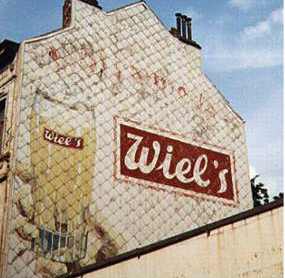The directory «Plots»
Wiels

Lambert Wielemans married Constance-Ida Ceuppens on November 14, 1838. The couple established the Wielemans-Ceuppens dynasty which would head up the brewery until the 1980’s. After having taken over a bakery operation without much success, they started up a cloth business. Business went well and the couple wanted to extend their activities. So in 1862, Lambert Wielemans bought a beer business from his brother-in-law. Although their product was not yet made there, this date nonetheless marks the beginning of the Wielemans brewing activities.
In 1868, with assistance from her children, Constance-Ida Ceuppens, then widowed for five years, began production and brewing of their own beer. For about ten years, the Wielemans rented the Roche-Soyez brewery, located in the center of Brussels on rue Terre-Neuve. Business flourished and the premises rapidly became too cramped.
In order to respond to the growing demand and to adapt their production equipment to the latest innovations, the Wielemans decided in 1930 to erect a new brew hall. The building designed by Adrien Blomme housed two times four vessels: a mash tun, a lauter tun, a filtration tun and a boiling kettle, making it the largest brew hall in Europe. Quickly baptised “The Wielemans Tower”, this building would serve as a landmark in the Brussels landscape, becoming an impressive showcase for the business through its special modernist architecture.
Also during the 1930s new beers were added to the range offered, such as Forst, l’Extra-Foncée or Nationale. In 1936, Prosper Wielemans died and his son Léon succeeded him, continuing the expansion of the family business. In 1938, the Wielemans purchased the Marly brewery and transferred their malting activities there. In 1940, war once again intervened, slowing down production. Raw materials were scarce and a decree by the German occupation limited alcohol content to 0,8°. This “fluitjesbier” (whistles beer) is called “Wiel’s”.
In November 1988, only two months after the Artois group had sold its equipment to a wholesaler of used brewery plant equipment, two of the eight tuns were dismantled. In spite of the outcry by the non-profit organisation La Fonderie, which protects the economic and social history of the Brussels Region, two other tuns were destroyed, thus ignoring the historical and heritage value of this equipment. It was only then that the Regional Development Society purchased the four remaining tuns for 2 million Belgian francs, thereby saving a part of the industrial history of Brussels from destruction. At the same time, the building, which was still the property of Interbrew, was classified by the Architectural Heritage Commission.
In April 1989, Artois sold the complex to the AMG Development Society who proposed transforming the brew hall into a museum of industrial technology, and constructing a center on the site for small and medium enterprises, housing, offices and a high-tech center.
In September 1989, Michel Villers, who had become 25% owner of the site, managed to convince a Swiss architectural firm to turn the complex into a center for “unusual and original businesses”. This new project, consisting of a surface area of 16,500 square meters, provided for a high-class restaurant, offices for businesses in the design and fashion sectors and even luxury lofts.
Two years later, the fate of the former Wielemans brewery was still not settled. On April 12, 1991, Le Soir reported on a new lead: the pensions office was looking to relocate in the eventuality that it sold the Midi Tower which it owned. In spite of its many defects, the site in Forest was a serious possibility. A project was even designed by the Metzger-Deleuze architectural firm in which the Blomme building, the former brew hall and the Wielemans offices would be integrated into the new construction. Once again the project was abandoned and the site continued to deteriorate.
In November 2001, when the Blomme building was only estimated at a worth of 13 million Belgian francs, the Brussels Capital Region initiated an expropriation procedure under the auspices of the 1993 ruling regarding heritage protection The Region thus became owner of the “Blomme” and of the former machine room and was looking for a new project to rehabilitate the buildings. The Region retained the idea of creating an important center for contemporary art there.
At the present time, the restoration and refurbishing work is in progress. A center for contemporary art in Brussels, which everyone has been awaiting for years, was open its doors in December 2006.
Belgium, 2010, The Wielemans Tower

